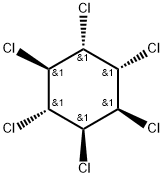Other grades of this product :
| ALPHA-HCH Basic information |
| ALPHA-HCH Chemical Properties |
| Melting point | 156-161 °C(lit.) | | Boiling point | 373.64°C (rough estimate) | | density | 1.9 g/cm3 | | vapor pressure | 173 at 25 °C (subcooled liquid vapor pressure calculated from GC retention time data, Hinckley etal., 1990) | | refractive index | 1.60-1.626 (589.3 nm 20℃) | | Fp | 11 °C | | storage temp. | APPROX 4°C
| | solubility | Soluble in ethanol, benzene, chloroform (Weast, 1986), cod liver oil, and octanol (Montgomery,
1993) | | form | Solid | | color | White | | Water Solubility | 2mg/L(25 ºC) | | BRN | 7073451 | | Henry's Law Constant | 0.888 at 5 °C, 1.58 at 15 °C, 2.27 at 20 °C, 2.96 at 25 °C, 6.02 at 35 °C:in 3% NaCl solution: 1.48
at 5 °C, 2.76 at 15 °C, 5.23 at 25 °C, 7.20 at 35 °C (gas stripping-GC, Cetin et al., 2006) | | Stability: | Stable. Incompatible with strong oxidizing agents. | | EPA Substance Registry System | .alpha.-Hexachlorocyclohexane (319-84-6) |
| ALPHA-HCH Usage And Synthesis |
| Chemical Properties | BHC is a white-to-brownish crystalline solid
with a musty, phosgene-like odor. | | Physical properties | Brownish to white monoclinic prisms, crystalline solid or powder with a phosgene-like odor
(technical grade). An odor threshold concentration of 88 μg/kg was reported by Sigworth (1964). | | Uses | Not produced commercially in the U.S. and its sale is prohibited by the U.S. EPA. | | Uses | α-1,2,3,4,5,6-Hexachlorocyclohexane is an organochloride which is one of the isomers of hexachlorocyclohexane and is an byproduct of insecticide Lindane (L465990). | | General Description | White crystalline powder. | | Air & Water Reactions | Insoluble in water. | | Reactivity Profile | Halogenated aliphatic compounds, such as ALPHA-HCH, are moderately or very reactive. Reactivity generally decreases with increased degree of substitution of halogen for hydrogen atoms. Materials in this group may be incompatible with strong oxidizing and reducing agents. Also, they may be incompatible with many amines, nitrides, azo/diazo compounds, alkali metals, and epoxides. | | Health Hazard | ACUTE/CHRONIC HAZARDS: Carcinogen. Toxic. Irritant. Hazardous decomposition product. | | Fire Hazard | Non-combustible, substance itself does not burn but may decompose upon heating to produce corrosive and/or toxic fumes. Some are oxidizers and may ignite combustibles (wood, paper, oil, clothing, etc.). Contact with metals may evolve flammable hydrogen gas. Containers may explode when heated. | | Safety Profile | ConfEmed carcinogen
with experimental carcinogenic,
tumorigenic, and neoplastigenic data. Poison
by ingestion. Mutation data reported. When
heated to decomposition it emits toxic
fumes of Cl-. See also BENZENE
HEXACHLORIDE and other
benzenehexachloride entries. | | Potential Exposure | The major commercial usage of BHC
is based upon its insecticidal properties. α-BCH is used as
an Agricultural chemical, pesticide, pharmaceutical, and
veterinary drug. The 7-isomer has the highest acute toxic ity, but the other isomers are not without activity. It is gen erally advantageous to purify the 7-isomer from the less
active isomers. The γ-isomer acts on the nervous system of
insects, principally at the level of the nerve ganglia. As a
result, lindane has been used against insects in a wide range
of applications including treatment of animals, buildings,
humans for ectoparasites, clothes; water for mosquitoes;
living plants; seeds and soils. Some applications have been
abandoned due to excessive residues, e.g., stored food stuffs. By voluntary action, the principal domestic producer
of technical grade BHC requested cancellation of its BHC
registrations on September 1, 1976. As of July 21, 1978, all
registrants of pesticide products containing BHC voluntar ily canceled their registrations or switched their former
BHC products to lindane formulations. | | Environmental Fate | Biological. Clostridium sphenoides degraded α-BHC to δ-3,4,5,6-tetrachloro-1-cyclo hexane (Heritage and MacRae, 1977a). In four successive 7-day incubation periods, α-
BHC (5 and 10 mg/L) was recalcitrant to degradation in a settled domestic wastewater
inoculum (Tabak et al., 1981).Soil. Under aerobic conditions, indigenous microbes in contaminated soil produced
pentachlorocyclohexane. However, under methanogenic conditions, α-BHC was converted
to chlorobenzene, 3,5-dichlorophenol and the tentatively identified compound 2,4Photolytic. When an aqueous solution containing α-BHC was photooxidized by UV
light at 90–95°C, 25, 50 and 75% degraded to carbon dioxide after 4.2, 24.2 and 40.0
hours, respectively (Knoevenagel and Himmelreich, 1976). In basic, aqueous solutionChemical/Physical. Emits very toxic chloride fumes when heated to decomposition
(Lewis, 1990). α-BHC will hydrolyze via trans-dehydrochlorination of the axial chlorines
resulting in the formation of hydrochloric acid and the intermediate 1,3,4,5,6-pentachlo rocyclo-hexene. The intermediate will undergo further hydrolysis resulting in the formation
of 1,2,3-trichlorobenzene, 1,2,4-trichlorobenzene and hydrochloric acid (Kollig, 1993). | | Shipping | UN2761 Organochlorine pesticides, solid, toxic,
Hazard Class: 6.1; Labels: 6.1-Poisonous materials. | | Purification Methods | Crystallise it from EtOH. Purify it also by zone melting. Possible CANCER AGENT, TOXIC. [: Beilstein 1 H 23, : Beilstein 5 I 8, many isomers : Beilstein 5 III 41, 5 IV 55.] | | Incompatibilities | Incompatible with oxidizers (chlorates,
nitrates, peroxides, permanganates, perchlorates, chlorine,
bromine, fluorine, etc.); contact may cause fires or explo sions. Keep away from alkaline materials, strong bases,
strong acids, oxoacids, epoxides. Decomposes on contact
with powdered iron, aluminum, zinc, and on contact with
strong bases producing trichlorobenzene. | | Waste Disposal | A process has been developed
for the destructive pyrolysis of benzene hexachloride @
400 500℃ with a catalyst mixture which contains 5 10%
of either cupric chloride, ferric chloride; zinc chloride; or
aluminum chloride on activated carbon. |
| ALPHA-HCH Preparation Products And Raw materials |
|
